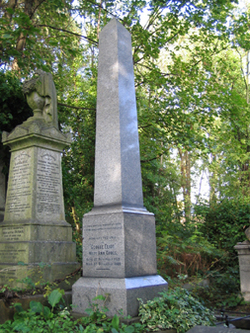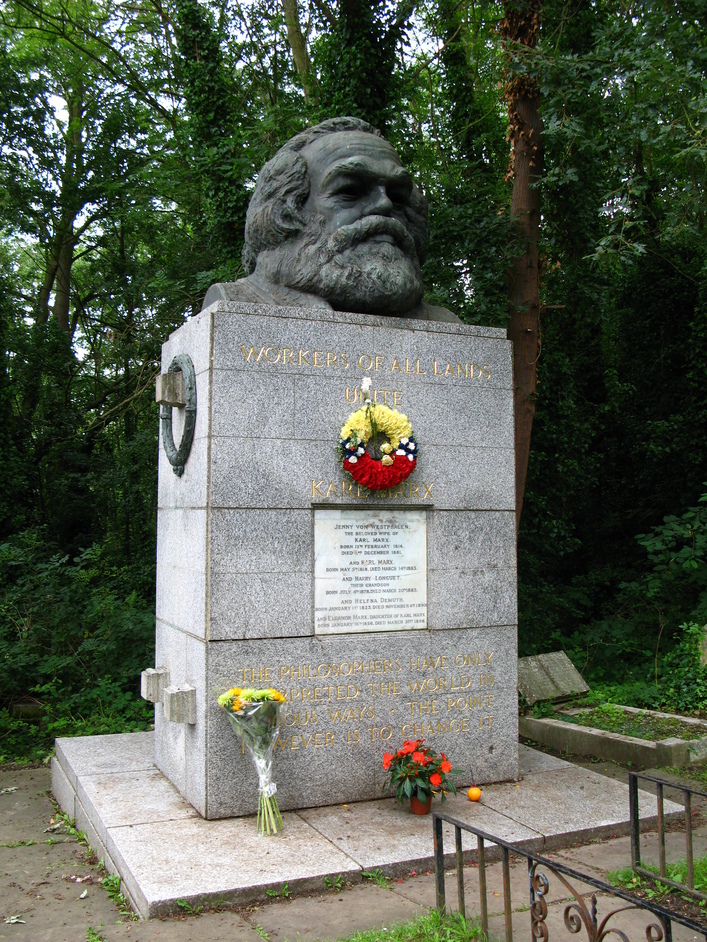Grave & Victorian Identity
‘Of all
the pulpits from which humans voice is
ever sent forth, there is none for which it reaches so far as from the grave’-
John Rushkin.
It is
well known that the Victorians had a morbid obsession with death. Infant mortality, death due to labour and disease where widespread as shown by F.S Schwarzbach, ‘The over all
mortality rate was 22% per thousand, and the infant mortality rates was roughly
150%( By contrast, 100 years earlier , the figures were 50% and 400%-500%)’ and so was part of everyday life for the
Victorians. Their attitude to death was
one of acceptance, just another fact of life but also of great fascination .
There
were many cases were people came back to life after being dead a while and
certainty of being dead and moving on to the next world became a great concern,
séances became popular among other occult activities to communicate with loved
ones to make sure they were at peace. It
was also the era when the Gothic had developed and therefore architecture,
ornaments and memorials became increasingly the focus of society’s’ attention.
Architects also discussed and debates architecture and sculptures made.
Augustus W.N. Pugin, a well-known Gothic architect one of the of the main
designers of the Palace of Westminster said , ‘In pure architecture the
smallest detail should have a meaning
and serve a purpose’. And so a person’s identity, class and personality could
be symbolised by their graves. These two things combined with the importance of
identity and knowing ones place, in the
strict class system of the age all came
together and was displayed in cemeteries
and graveyards. A person’s grave during
this period, like in many other preceding ages was of great importance and
became the final statement to the world as Rushkin’s aforementioned quote
states.
Death
itself to the Victorians was like falling asleep and traversing to the
afterlife for judgement. This can be read in Robert Louis Stevenson’s , ‘ The
Body Snatcher, 1884, ‘ To bodies that had been laid in earth, in joyful
expectation of a far different awakening, there came that hasty, lamp –lit,
terror-haunted resurrection of the spade and mattock’ (80).
This came from
Christianity beliefs as demonstrated in this quote, ‘According to the Lord’s
word, we tell you that we who are still alive, who are left until the coming of
the Lord, will certainly not precede
those who have fallen asleep.’ Since
the soul was to be prepared, final rites were enacted on death beds and the
Lords prayer, in which humility is a large part of the faith (Psalms 25:9) ,
‘He leads the humble in what is right, and teaches the humble his way’. This
ultimately is what causes a clash and controversy when it came to graves being
a symbol of status, a some saw it as a vain final statement (quote). This is reflected in Robert Browning’s poem, ‘ The Bishops
Orders His Tomb at Saint Praxed’s Church:
‘And
somewhat of the choir those silent seats/ And up into the aery dome where live
the angels/…..And ‘neath my tabernacle take my rest/ wit those nine columns
round me, two and two/ the odd one at my feet where anslem stands/
Peach-blossom marble all, the rare, the ripe..'
This shows, in a vain light, the preparations
for graves and how everything would be thought out, partly with meaning but
also as is the case in this poem partly for show to society. Here are some
examples of elaborate graves by well-known Victorian gentry.
On
example is George Eliot’s grave, in the formation of a large monument in one of
England’s most famous cemeteries, part of the magnificent seven cemeteries of the
age- Highgate. It’s large scale
demonstrate the eccentric architectural side in relation to death in Victorian Britain.
Another grave the be noted is one of a person
unknown, upon is sculpted an sleeping
angel .
Another famous grave is that of Karl Marx in
which, on top of a large stone, is a gigantic sculpture of his head.
This
shows how everything was meticulously planned out, also signifying status and
meaning of the body occupying the grave.
For the
lower classes death was an entirely different business. Firstly the death rate was extremely high
amongst the poor due to terrible sanitary conditions, inhabiting rooms with
dozens of their people and the conditions in the streets or factories where
they lived. There was also the issue of religious burial, sometimes denied by
priests due to the late persons’ life contradicting church rules or a scandal ,
this occurred in the case of even the
famous Lord Byron, a the head of Westminster abbey refused to bury him due to ,
“ Questionable morality” .
The poor
would have a small funeral as described here by Julie-Marie Strange, ‘Stripped
of all mourning paraphernalia, the pauper coffin bore little of no indication
of the individual personality of the corpse or those who mourned it.’ . They would
still be provided with Christian Burials, the way to tell is if the tomb is
facing eastwards as this was the way pointed towards Jerusalem. During this
time there was also a tradition of placing coins on the eyes of the deceased
which harks back to ancient Greek belief. Charon was the ferry man in the
underworld and for those passed on to pay for their passage they would have
coins placed over the eye, this is a strand of pagan belief , just as occult practices, found intertwined in many Victorian rituals. They would also often be placed in mass
graves usually marked by a simple wooden cross for a head stone, incredibly
humble in comparison to the upper class’ burial practices and would state a lot
about the class of people buried. Over all the presentation of the dead in the
form of their graves was of great importance and reflected not only the
identity of the deceased but also the Victorian era itself.Works cited:
(1)Rushkin,
John. The Lamp of Memory. Dover
Publication.1885.
(2)Kuich,
John. Schwarzbach, FS. The Victorians and Death. Journal. Page 875
(3)Pugin,
A.W.N. Quote, 1841: http://www.ilikearchitecture.net/2013/09/quote-81-augustus-w-n-pugin/
(4)
Robert Louis Stevenson The Body Snatcher. Strange Case f Doctor Jekyll and Mr
Hyde and Other Tales. 1884. Oxford
World’s Classics
(7)Browning,
Robert. My Last Duchess and Other Poems. Dover Thift Edition. 1993.
(8)Body Snatching: http://cdn.ltstatic.com/2007/June/GQ674345_942long.jpg
(9)Unknown
grave: Hightgate cemetery http://upload.wikimedia.org/wikipedia/commons/1/11/Sepulcro_con_%C3%A1ngel.jpg
(10)Karl Marx:http://cdn.ltstatic.com/2007/June/GQ674345_942long.jpg
(11)George
Eliot: Highgate cemetery:
(12)Carno,
Carol Lorraine.Mad Lords and Irishmen:
Representations of Lord Byron and Oscar Wilde Since 1967. Google Books
(14)Strange,
Julie Marie. Only a Pauper Whom Nobody Owns: Reassessing the Pauper Grave c.
1880-1914, Page [148]





I really like that fact you related your work to Robert Browning's poem, it fits in well with the context of your topic. I also kept thinking about Wuthering Heights, Heathcliff being obsessed with visiting Cathy's grave and his desire to be buried with her – he wants what you described as his ‘final statement’ to be with Cathy forever.
ReplyDeleteMy name is Diego from Argentina and I want to share with you all how I got my ex back after she left me on the 20th of may because of some misunderstanding between us, I tried to resolve it with her but she never gave me a chance , i begged and begged but she said she was done . two weeks ago I came in contact with Dr Donald , I explain to him how I have been trying to get my ex back but all to no avail and he told me to give him my ex name and photo and I gave him and he told me that 24 hours from now my ex girlfriend will come back to me I left with little faith, Behold the next day my ex girlfriend was at my apartment rigging the door bell I opened the door and she went on her knees begging me to accept her back I quickly grab her and carried her inside and since that day till now and forever we are happily together and our love keeps growing stronger . a big thanks to to dr Donald you can contact dr Donald through donaldsolutiontemple@yahoo.com you can also reach him on WhatsApp +1 (938) 2044894 for any spell and solution to your illness and diseases thank you
ReplyDelete